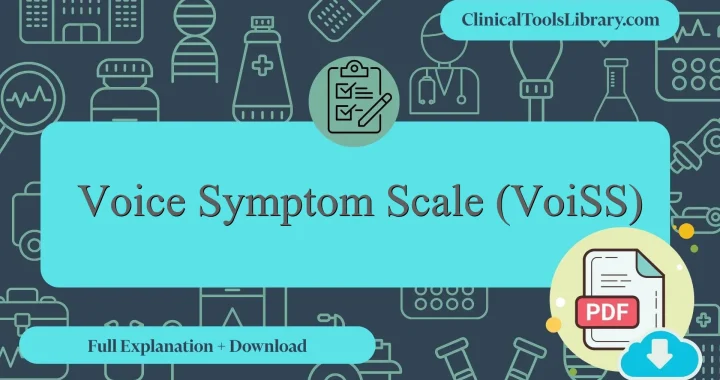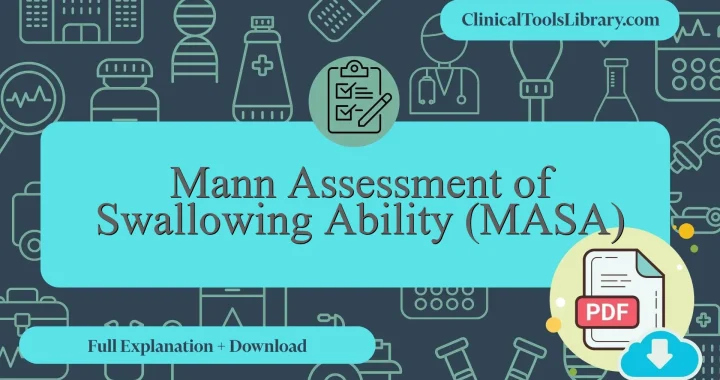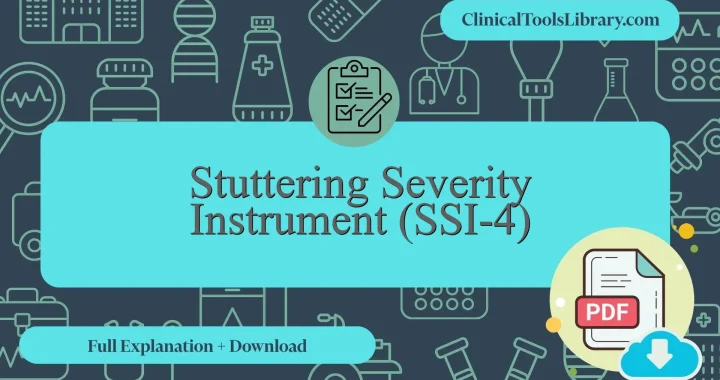In this article, we explain everything you need to know about the Voice Symptom Scale (VoiSS). We will cover the aspects it evaluates, the target population, a detailed step-by-step explanation, and how to interpret its results. Additionally, we will dive into the scientific evidence supporting this tool (diagnostic sensitivity and specificity) in clinical assessment. You will also find official and unofficial sources available for download in PDF format.
What does the Voice Symptom Scale (VoiSS) assess?
The Voice Symptom Scale (VoiSS) is a validated self-assessment tool designed to evaluate the presence and severity of voice disorders by measuring symptom frequency and impact on daily functioning. Its primary purpose is to quantify the patient’s perception of voice-related quality of life, offering a comprehensive profile of phonatory issues through domains such as physical symptoms, vocal impairment, and emotional consequences. The VoiSS provides reliable data for clinical decision-making and progress monitoring, serving as an alternative or complement to instruments like the Voice Handicap Index and the Speech Handicap Index PDF. This scale is widely referenced in research and practice, with the Voice Symptom Scale pdf available for standardized administration and scoring.
For which type of patients or populations is the Voice Symptom Scale (VoiSS) intended?
The Voice Symptom Scale (VoiSS) is primarily indicated for patients presenting with functional or organic voice disorders, including conditions such as muscle tension dysphonia, vocal fold nodules, and laryngeal inflammation. It is extensively utilized in otolaryngology and speech-language pathology settings to assess the severity and impact of voice symptoms on daily functioning. The VoiSS is particularly valuable in quantifying voice-related impairment in professional voice users, such as teachers and singers, where precise evaluation of symptomatology guides therapeutic decision-making. Compared to other instruments like the Voice Handicap Index and tools measuring voice-related quality of life, VoiSS offers a multidimensional assessment focusing on symptom frequency, emotional impact, and physical discomfort, making it most useful in both diagnostic and monitoring phases of treatment for voice disorders.
Step-by-Step Explanation of the Voice Symptom Scale (VoiSS)
The Voice Symptom Scale (VoiSS) consists of 30 items designed to assess the subjective impact of voice disorders on patients. It comprises questions related to three domains: Impairment, Emotional aspects, and Physical symptoms. Each item utilizes a 5-point Likert scale ranging from 0 (“never”) to 4 (“always”), allowing respondents to indicate the frequency or severity of specific voice-related issues. The clinician administers the questionnaire by instructing the patient to reflect on their experiences over the past week and select the most appropriate response for each statement. After completion, scores are summed by domain and globally to quantify symptom severity, facilitating evaluation in conditions such as laryngeal disorders or vocal fold dysfunction. This structured approach ensures reliable patient-reported data to inform clinical decision-making.
Voice Symptom Scale (VoiSS) PDF Downloads for Voice-Related Quality of Life Assessment
Downloadable resources are available below, providing the Voice Symptom Scale (VoiSS) in both its original language and the English version, each formatted as a PDF. These documents serve as essential tools for the assessment of voice-related quality of life and aid clinicians in the accurate evaluation of patient-reported symptoms. Access to both versions ensures comprehensive utilization across diverse clinical settings and supports standardized data collection for comparative research and diagnosis.
How to interpret the results of the Voice Symptom Scale (VoiSS)?
The Voice Symptom Scale (VoiSS) test quantifies the degree of voice-related impairment by generating a score based on patient responses across three domains: physical symptoms, vocal impairment, and emotional impact. Scores typically range from 0 to 100, with higher values indicating greater perceived voice disability. Reference values established in clinical studies suggest that a total score below 15 is considered within normal limits, whereas scores exceeding 30 signal moderate to severe dysphonia. For practical interpretation, clinicians calculate the total score by summing individual item responses, and comparative analysis against normative data assists in monitoring disease progression or treatment efficacy. For instance, a patient scoring 45 points may warrant further evaluation for potential vocal fold lesions or other pathologies. Thus, the VoiSS score enables healthcare professionals to quantify symptom severity objectively, guide therapeutic decisions, and track patient-reported outcomes over time.
What scientific evidence supports the Voice Symptom Scale (VoiSS) ?
The Voice Symptom Scale (VoiSS) was developed in the late 1990s as a patient-reported outcome measure specifically designed to assess the multidimensional impact of voice disorders on quality of life. Its validation process entailed rigorous psychometric testing, including assessments of reliability, internal consistency, and construct validity, with results consistently demonstrating high Cronbach’s alpha coefficients (>0.9) across diverse populations. Subsequent studies have confirmed its sensitivity and specificity in detecting symptoms associated with dysphonia and other laryngeal disorders, establishing it as a validated tool in clinical and research settings. Cross-cultural adaptations and translations have further reinforced its applicability, supported by factor analyses that maintain the original test’s structural integrity. This evidence underscores the VoiSS as a scientifically robust instrument for symptom quantification in voice pathology evaluations.
Diagnostic Accuracy: Sensitivity and Specificity of the Voice Symptom Scale (VoiSS)
The Voice Symptom Scale (VoiSS) demonstrates a reported sensitivity ranging from 83% to 86%, indicating its effectiveness in correctly identifying patients with voice disorders. The specificity of the VoiSS typically falls between 63% and 67%, reflecting its ability to distinguish individuals without laryngeal pathologies. These values underscore the instrument’s utility as a reliable patient-reported outcome measure in assessing the presence and severity of dysphonia. Variations in sensitivity and specificity have been noted across different clinical populations, emphasizing the importance of contextual interpretation of VoiSS scores during voice disorder evaluations.
Related Scales or Questionnaires
The Voice Handicap Index (VHI) and the Voice-related Quality of Life (V-RQOL) questionnaire are commonly considered comparable to the Voice Symptom Scale (VoiSS). Both tools assess the perceived impact of voice disorders on a patient’s daily functioning, with the VHI offering a well-established multidimensional approach including functional, physical, and emotional domains. The V-RQOL provides a brief yet reliable metric focused primarily on quality of life aspects. Advantages of the VHI include its extensive validation across diverse populations, while a disadvantage is its length, which may limit clinical feasibility. Conversely, the VoiSS is praised for its specific symptom-focus and sensitivity to changes post-therapy, though it may not capture broader psychosocial effects as comprehensively. The Speech Handicap Index (SHI), although more oriented towards speech disorders, shares conceptual similarities in evaluating communicative impact, but is less targeted to voice-specific pathology. Each of these scales and questionnaires is thoroughly described and available for download on ClinicalToolsLibrary.com, including the Voice Symptom Scale pdf and the Speech Handicap Index PDF, facilitating their integration into clinical practice.




